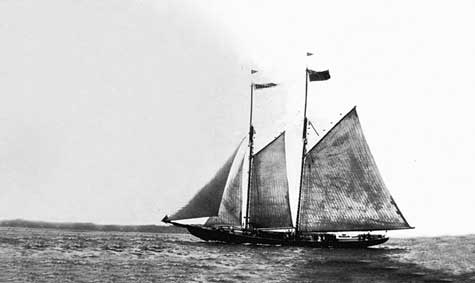Rarely have so many interesting and dissimilar events and circumstances come together in the history of a ship as they do in the case of the emblematic Canadian schooner, the Bluenose. Designed and built as a fishing boat, the winner of international regattas, subsequently converted into a cargo ship, detained at sea by a German submarine during World War II, shot at by the U.S. Coast Guard, this vessel, also known as the “Queen of the North Atlantic,” represented its country in ceremonies abroad and its image is engraved on Canadian dimes and printed on a number of different Canadian postage stamps.
At the dawn of the 20th century, fleets of schooners were used for fishing in the Grand Banks area off the New England coast. Fishing boats were launched from those schooners on the open sea, and they remained there for hours or even days, carrying out their rough work despite the cold and squalls. The first of those schooners that returned to port, loaded with fish, would get the best prices for its cash. Naturally, this created heavy competition, which was especially intense between the Canadian and U.S. fleets. That’s when the idea came up of holding an annual regatta for fishing boats from the two countries — the International Fisherman’s Cap Race. The first one was in 1920, and the winner was the U.S. sailboat the Esperanto.
A few months later, on March 26, 1921, the Bluenose, a schooner sailing ship, was launched into the waters of Lunenburg, Nova Scotia. It was 34 meters long, 8 meters wide and had a displacement of 258 tons. After completing its first fishing season in the Grand Banks, the Bluenose represented Canada in the following regatta and beat the U.S. ship the Elsie. It was the first of a series of victories for the Bluenose, which remained unbeaten for 17 years. The schooner became so famous that in 1929, a 50-cent postage stamp was issued that depicted it sailing full speed ahead, and since 1937, the Canadian dime, which features the profile of the United Kingdom’s sovereign on one side, has also featured the Bluenose. (Other stamps related to the schooner or its captain, Walters, were issued in 1982 and 1988.)
In the 1930s, schooner sailing ships began to become obsolete, replaced by schooners with engines. As a result, the Bluenose was modified: its masts were shortened and two diesel engines were installed. However, a drop in the prince of fish at the end of that decade led to it almost being auctioned off in 1939, coinciding with the start of World War II.
As the war got underway, the presence of German submarines in the waters of the Caribbean and the Gulf of Mexico and along North America’s Atlantic Coast had practically brought maritime traffic in those areas to a standstill. In 1942 alone, German U-boats sank more than 400 ships in those waters, and this also affected fishing in the Grand Banks. Under these circumstances, two spunky young adventurers from the United States, Thomas Higgins II and Jesse Spalding III, came up with the idea of transporting goods on small ships that would not attract the attention of German submarines, which were busy hunting large freighters and oil tankers. In 1942, they bought the Bluenose, which had been moored for a year, to use it for transporting freight between ports on the Atlantic Coast of North America and the Caribbean, especially Havana, which was a very lucrative business. The schooner was used to move all types of cargo; in fact, at the request of U.S. government agencies, it transported dynamite used for building airfields in the Caribbean. It also transported bombs and aviation fuel, along with various foodstuffs. For three years, from May 1942 to May 1945, the Bluenose entered and departed from the bay of Havana an average of three or four times monthly. The composition of its crew gradually changed, and eventually it was mostly Cuban.
According to an account by one of the schooner’s owners, Jesse Spalding, it was during one of these voyages between Havana and Florida, near the lighthouse of Cayo Sombrero, that the ship was intercepted by a German submarine. Spalding said that an officer from the submarine, speaking in correct English, asked for their identification and the reason for their voyage, and when the Bluenose’s captain said it was fishing, the officer refuted him: “You are the Bluenose, which has sailed from Havana, with freight, for Port Everglades. If I didn’t like your boat, I would sink it right now. Continue on your way and don’t come back. Next time, it will be a different story.” That being said, the submarine submerged. It was a demonstration of German intelligence activity in Cuba, especially in Havana, Spalding commented.
The eventful existence of the Bluenose ended abruptly on January 28, 1946, when it was caught in a storm and shipwrecked on a reef near Aux Cayes, Haiti. The crew made it out alive.
In 1963, a replica of the Bluenose was built in Lunenburg following the plans for the original: the Bluenose II. In 1971, this vessel was bought by the Nova Scotia government, which uses it for tourism.










